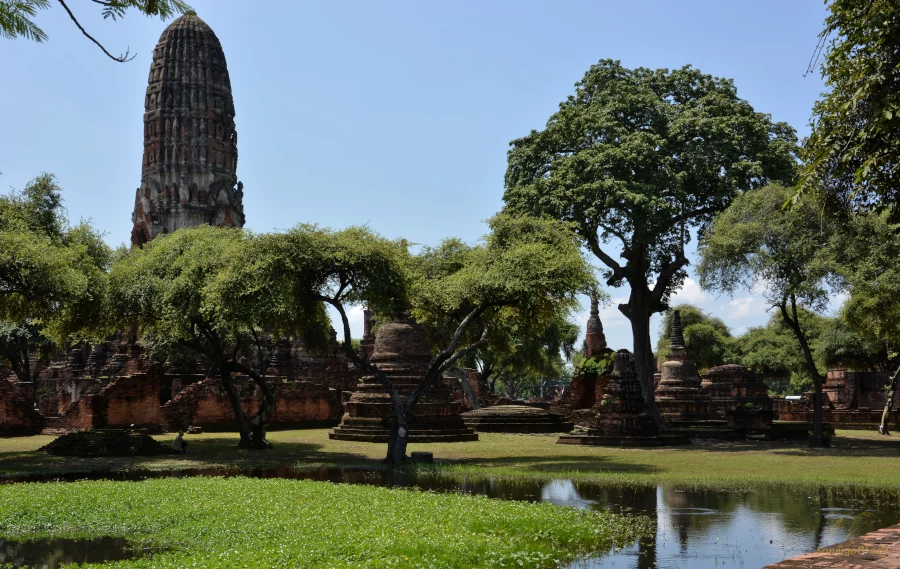
From Bangkok in Thailand, it is easy to travel to the northern city of Ayutthaya. I prefer the Thai railroad, which is already a bit nostalgic – with all the advantages and disadvantages in the wooden class such as dense crowds at rush hour, thick air, wind from the fans on the ceiling, but also quiet travel speed, glimpses of backyards and alleys, contacts with locals, etc… For me, this is entertaining and belongs to the impressions in a foreign country, a different culture absolutely. Especially since both fellow passengers and conductors are always friendly and I feel comfortable in this atmosphere.
Ayutthaya is a destination in a rather rural area, even though the city with about 53,000 inhabitants already counts as a big city in Thailand. This is especially practical if you want to get out of the metropolis of Bangkok – for example, because you have just arrived and are still struggling with jetlag. The journey from Bangkok by train takes about 1.5 hours.
Palace ruins and temples between rivers, canals and parks – Ayutthaya historical park
If you arrive in Ayutthaya by train, you will have to make your way to the center. If you don’t take a cab or motorcycle cab, the footpath opposite the train station goes into the small cross street. It is a dead end and ends after a few hundred meters at a river, the Maenam Pasak. From there a ferry leaves during the day (until 8 pm.) to the city center. If you arrive later, you have to walk back a bit parallel to the railroad line and use the big road bridge.
Then you end up in a piece of modern city – wide, busy streets, concrete houses, bad sidewalks, stores, advertising… Don’t let it scare you – behind it are quieter neighborhoods and especially the remains of the historical capital of the Ayutthaya Empire.
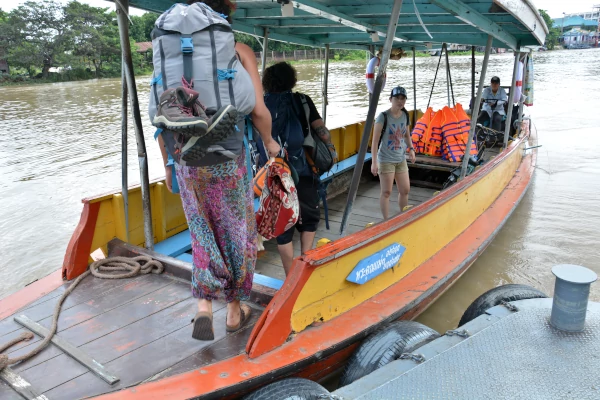
The water wealth and the city
Ayutthaya is located at the confluence of three rivers – the Chao Phraya, the Mae Nam Lop buri and Mae Nam Pa Sak. Already in the first years of the Ayutthaya Empire, a connection between the Lop buri and the Pa Sak was created by a canal, which formed an island. On this island the historical center of Ayutthaya was built. This island is situated somewhat higher than the surrounding flat land, so that it protruded during floods. This gave a military advantage at least for the first decades of the Siam Empire, because sieges were hardly possible. In addition, canals were dug through which the supply of the city was essentially handled.
Hard to imagine, but Ayutthaya was once located near the coast of the Gulf of Siam. Today, this coastline is almost 100km away, with the metropolis of Bangkok still in between! The rivers brought tons of sediments from the north of Thailand, which they deposited at the mouth. This has pushed the coastline further and further out to sea.
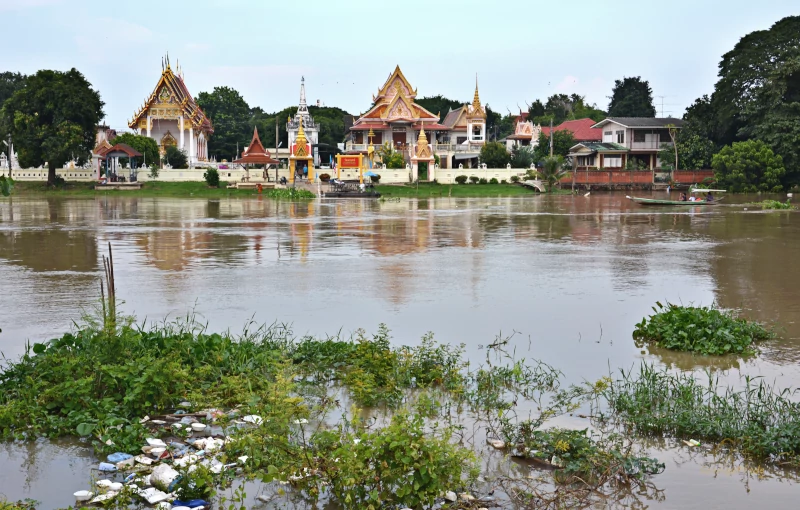
Extensive sights – Historical park Ayutthaya
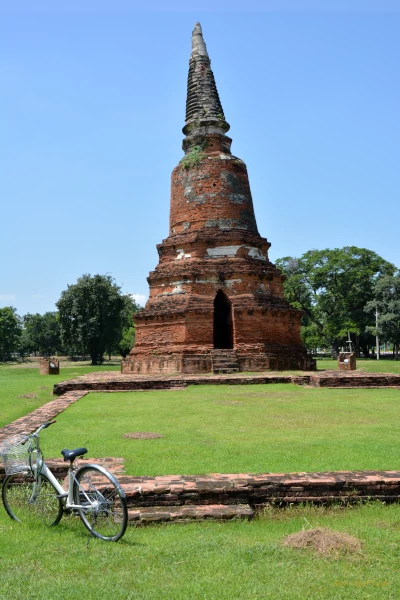
Today, the old capital of the Siam Empire of Ayutthaya is largely a „historical park“. This is how the Thai Ministry of Culture (Fine Arts Department) has been developing the major historical sites in Thailand since the 1950s. A great deal of research is being done, and a great deal of effort is also being put into preserving the building fabric and cultural objects. And of course, the historical sites are made accessible to interested guests from Thailand and the world. The monuments and sites of Ayutthaya have been UNESCO World Heritage Sites since 1991.
You should rent a bike, at least for a few days! Ok, mopeds are also available, but you won’t get very far with them. With a bike you can comfortably ride around in most of the parks. This way you avoid having to walk in the heat through the spacious facilities. Many guesthouses and other rental companies offer bicycles by the day.
Not all temples and ruins are located in the Historical Park. So there is still a lot to discover all around. And by the way, the extensive parks with green areas and waterways are also interesting to observe exotic animals, especially birds.
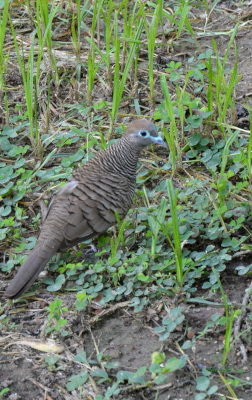

Palaces and Temples in Ayutthaya Historical Park
The Old City of Ayutthaya History Park includes the remains of several palaces, some of which are being reconstructed. There is Wang Luang, the Old Residence Palace and the Chandra Kasem Palace. The latter was built as the residence of King Naresuan, who ushered in the second great phase of the Siam Empire of Ayutthaya with his seizure of power at the end of the 16th century. Of the palaces sometimes only foundation walls stand, but it has been started to rebuild individual buildings splendidly.
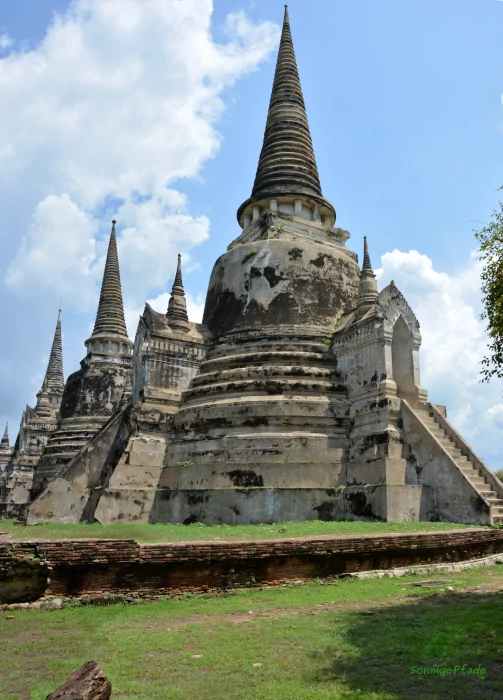
In the old capital there were also a number of temples as spiritual and ritual centers. Wat Phra Si Sanphet, with its three large chedis, is the most important sight of Ayutthaya. The spiritual center was Wat Mahathat. For the temple tour between the five main temples in the Ayutthaya History Park there is a general ticket.
At Wat Lokayasutharam, the Temple of the Earth, there is a 42-meter-long reclining Buddha. The head of the Buddha rests on the right hand and is supported on four lotus – buds.
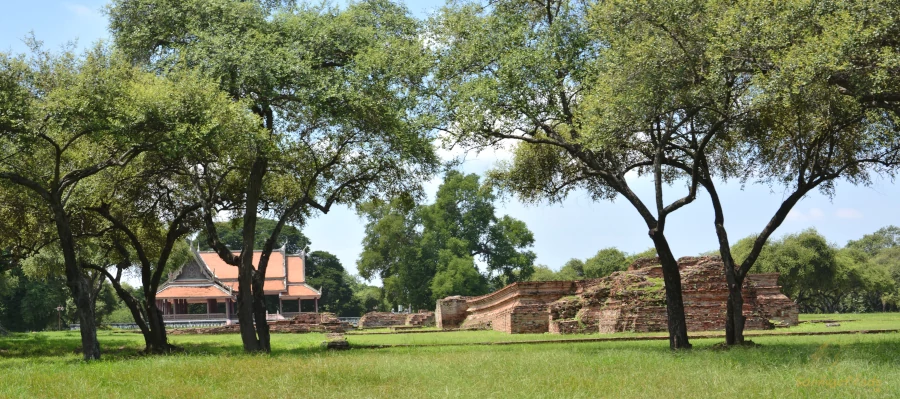
Museums at the Historical Park
The historical presentation of the Ayutthaya History Park also includes museums.
The Chao Sam Phraya National Museum presents findings from the Ayutthaya period such as carved votive tablets, Buddha statues and gold figures from the crypt of Wat Ratchaburana.
A modern building houses the Ayutthaya Historical Study Center. This primarily conducts historical research on the Siam Empire of the Ayutthaya period. A museum and a library are components of the science center. The architecture of the building was the result of collaboration between Thai and Japanese architects.
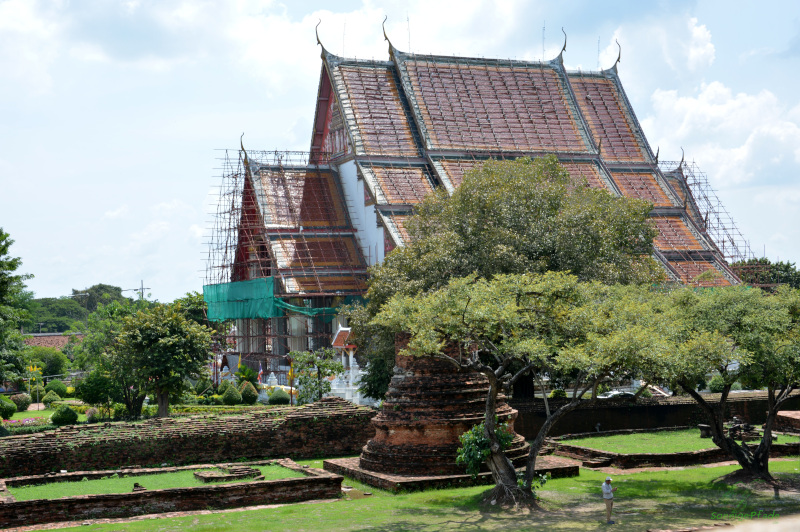
Boat tours in Ayutthaya
When floods are not paralyzing tourist traffic, a boat tour is possible for a change of pace on the many river arms and canals that surround the center and temple parks and circle the city core. Boat tours can usually be booked at the guesthouses, which are also happy to arrange tourist offers in the region.
The short history of the Siam Empire of Ayutthaya
The Siam Kingdom of Ayutthaya was founded by King U Thong (also called Ramathibodi I) in 1351. At that time, the Thai Siam Kingdom of Sukothai from 1238 and the Lan Na Kingdom in the north with the capital Chiang Mai from 1292 already existed. In the east, the Khmer ruled with the capital of Angkor (now in the territory of Cambodia) and in the west, strong kings were in power in Burma. The central Thai plain was ruled by various princes. Some provinces were also dominated by the Khmer, but sought stronger autonomy. U Thong sought the support of the Thai princes with their administrative and military experts as well as scholars from the Khmer elite in establishing the Ayutthaya Empire. In addition, traditional Indian and Chinese traders strengthened the economic base in the region. The vast land areas were focal points for rice cultivation and established trans-regional trade.
Strength through fusion – Ayutthaya and Sukhothai
The recognition of the kingdom of Ayutthaya by the Chinese emperor strengthened its position vis-à-vis the Sukothai Empire, which still existed in parallel, but which became increasingly affiliated and „merged“ through marriage alliances in 1438. Many of the progressive developments of Sukhothai, such as the written Thai language, administrative experience, the art of war and religious practices, were henceforth incorporated into the new Siam Empire. This strengthened the empire and enabled it to assert itself against its neighbors.
The progress of the development of the Siamese Ayutthaya Empire is characterized by many ups and downs. Not all kings were strong and could unify the princes. Again and again there were wars, especially with the neighbors from Burma. In the 16th century the first phase of Ayutthaya ended with the defeat against the Burmese rulers. Only the son of the governor appointed by Burma was able to re-establish the Thai empire and initiate the second Ayutthaya period from 1593.

Early peak of Asian-European world trade
It is interesting to note that the Siam Empire maintained far-reaching trade relations at an early stage. Already mentioned were the constant connections to China. But also Japanese traders came to Ayutthaya and established a branch there. At high times around 1620, up to 1500 Japanese lived in their own quarter and some were active as advisors at court. However, in a massacre in 1630, many of the Japanese were killed and the survivors expelled.
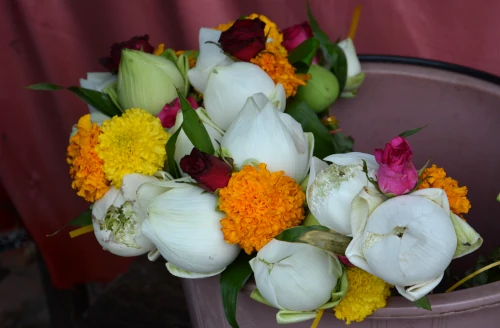
Around 1512, the first trade treaty was signed between Portugal and the Siam Empire, allowing the Portuguese to trade with Ayutthaya and in the Malay Peninsula. From 1598, Spain also began to establish trade relations with Siam, followed in 1606 by the establishment of the Dutch East India Company. The latter, however, did not see too many opportunities, but nevertheless operated a trade office for a long time.
The French also began to develop more extensive relations with the Kingdom of Siam from 1664. Siamese envoys stayed in Paris on several occasions. France partially replaced the Netherlands in trade relations, which considered trade unpromising. However, the French tried to build their own forts in Siam and to proselytize. This displeased the old Siamese aristocracy, who then called in a new, more regionally oriented government with a coup d’état.
Blossom and Decay of the Ayutthaya Empire
The 18th century brought Siam a period of prosperity in the first half of the century. Trade and economy flourished, new canals were dug and boats were built in Ayutthaya. Poetry and art enjoyed an upswing in the country and literary works were created that are still read and distributed in Thailand today. However, private interests weakened the central power of the Siamese king and the state. In foreign policy, Vietnam and Thailand vied for supremacy as the Southeast Asian regional power. Thus, a newly strengthened and increasingly aggressive Burma met a weakened Siam Empire.
After the Burmese army had already besieged Ayutthaya for months starting in 1760, a new major attack began in 1765. Two armies advanced on Ayutthaya in a pincer movement. After a year-long siege and a devastating city fire, the Burmese finally conquered the city on April 7, 1767. Art treasures and archives were largely destroyed, large cannons were sunk in the rivers, and the smaller ones were taken to Burma. Many of the inhabitants, especially artists, craftsmen and scholars, were to be deported to Burma.
Thus ended the approximately 400 year history of the Ayutthaya Siam Empire. The city was more or less extinguished, the empire disintegrated, many provinces declared themselves independent. In Thon Buri, about 80km south, the general Phraya Tak Sin founded a new capital and raised a new strong army. In doing so, he prevented the complete subjugation of Thailand to Burma’s rule.

[Contains *advertising links!]
Travel tips for Ayutthaya
Easy travel from Bangkok center
For the journey to Thailand see the info – post „Discover Thailand individually„, there you get all travel tips also for the whole north of the country.

The city of Ayutthaya is located only about 80km north of Bangkok and is very easy to reach by train from Bangkok’s Hua Lamphong station. With a passenger train (ordinary) it costs only about 15 Baht, so about 45 Eurocent, the trip takes about 1 3/4 hour. If you want to take it easy, away from the hectic metropolis of Bangkok, and first digest a little jetlag, then Ayutthaya is a welcome start in Thailand. For about 3€ there are otherwise regular connections with minibuses between Bangkok and Ayutthaya. Of course, it is also possible to travel by private cab (from about 45€). Searching and booking connections for all variants is easy online with 12go.asia*.

From the train station to the center of Ayutthaya
The core of the new Ayutthaia is located roughly between the train station and the old royal town and is not exactly a feast for the eyes. However, this is where most of the guesthouses are located around the Chao Phrom market.
Coming from the train station and taking the street just opposite, you first have to cross the river Maenam Pasak with a small ferry (5 Baht), then you are already in the modern center. If the ferry does not run after 8 pm., there is the further walk over the bridge south of the station.
Due to the short distance, local tour operators from Bangkok also offer to visit Ayutthaya for a day. But if you are really interested in Thai history and culture and you can organize your trip individually, you should take more time for the sights of Ayutthaya. There are enough accommodations in Ayutthaya in different price and comfort classes.
Onward journey to the north of Thailand

From Ayutthaya you can continue by train in practically all northern directions – to Chiang Mai* via Phitsanulok* with bus connection to Sukhothai*,to Nong Khai* via Korat with bus connection to the historical Khmer city Phimai or also to Ubon Ratchathani*.
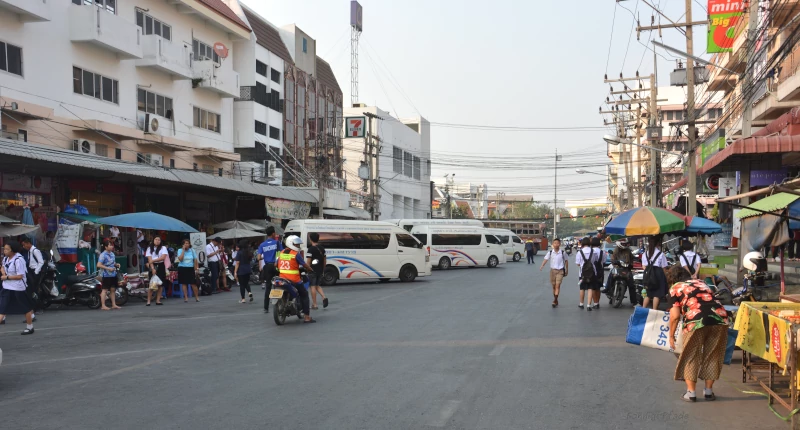
Accommodation in Ayutthaya
Ayutthaya has relatively many accommodations in different price ranges to offer. Due to its proximity to Bangkok and cultural importance, a trip to Ayutthaya for 2, 3 days or longer is in demand by many Thailand travelers. For budget travelers, there are a number of hostels available with dorm beds starting at around 100 ThB ( ca. 3€) and up. If you want to be on the safe side, you can book these in advance through hostelworld*. Many guesthouses also offer bicycles for rent, not always only for their own guests.
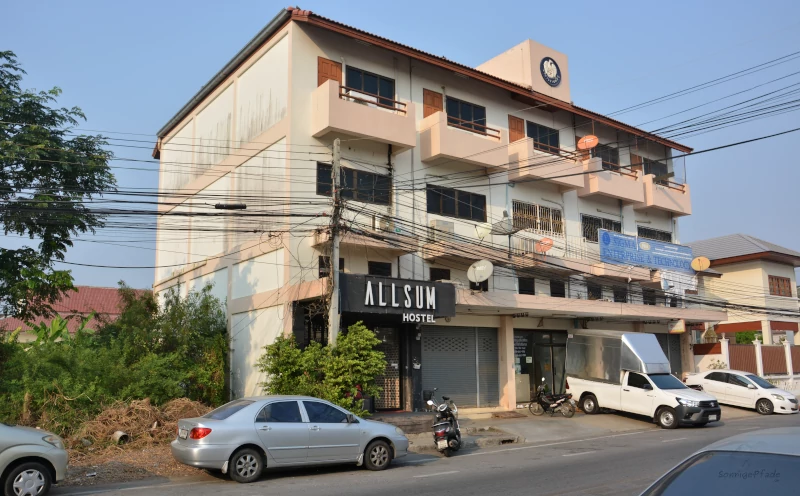
For those who value privacy and a more upscale standard, the city’s guesthouses are the place to go.
The Baan Thai House* is located near the floating market in a villa built in the traditional wooden style. It awaits its guests with a well-kept garden, pool and terrace. The temple complexes can be reached in 15 to 20 minutes on the house’s bicycles.
Also built with a lot of wood is the Baan Tye Wang Guesthouse*, which offers a beautiful view of one of the canals of Ayutthaya. The terraces and balconies invite you to sit, and the „rain showers“ are outdoors. Bicycles are part of the basic equipment, so that nothing stands in the way of a visit to the nearby palaces.
For those who prefer a modern bungalow-style accommodation, the Q Zone Boutique Hotel* is the place to be. Each room has its own outdoor area. A lounge and service desk with travel information and tour arrangements are available. The hotel also has an a la carte restaurant.
Already planning? Invite your friends to Ayutthaya!
If you liked the article and want to invite your friends to the history trip to Ayutthaya Siam Empire, then share the link to the post in your social media channels. A good echo on the internet strengthens the recognition by search engines and thus separates the wheat from the chaff. Thank you!

* Note on advertising links
Some links in this article are marked with *. You can reach a store, an agency or another commercial enterprise through them. If you buy or book something there, the sunny trails blog gets a commission to finance this blog. Nothing will be more expensive for you, because the commission is already included in the price.

